Showing Spotlights 185 - 192 of 544 in category All (newest first):
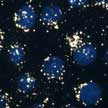 Currently available toxicity screening methods are not fully compatible with nanotoxicity studies. Due to the unique physicochemical characteristics of nanomaterials, conventional cytotoxicity assays have been shown to create complications in nanotoxicity evaluation. In a new study, researchers used surface-enhanced Raman scattering (SERS) to evaluate the cytotoxicity of nanomaterials. They show that SERS can be used as an alternative nanotoxicity evaluation method especially for the nanomaterials that have been shown to create complications in conventional cytotoxicity assays.
Currently available toxicity screening methods are not fully compatible with nanotoxicity studies. Due to the unique physicochemical characteristics of nanomaterials, conventional cytotoxicity assays have been shown to create complications in nanotoxicity evaluation. In a new study, researchers used surface-enhanced Raman scattering (SERS) to evaluate the cytotoxicity of nanomaterials. They show that SERS can be used as an alternative nanotoxicity evaluation method especially for the nanomaterials that have been shown to create complications in conventional cytotoxicity assays.
Sep 20th, 2016
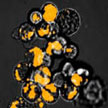 Very recently, the use of zwitterionic coatings has emerged as an alternative strategy to provide corona free nanoparticles. The layers of proteins adsorbed to the surface of a nanomaterial at any given time is known as the protein corona. This protein layer can hinder interactions between the targeting ligands at the surface of nanoparticles and their binding partners on the cells' surface. Researchers found that by using both zwitterionic- and targeting-ligands at the surface of nanoparticles, the shielding effects of protein corona can be reduced.
Very recently, the use of zwitterionic coatings has emerged as an alternative strategy to provide corona free nanoparticles. The layers of proteins adsorbed to the surface of a nanomaterial at any given time is known as the protein corona. This protein layer can hinder interactions between the targeting ligands at the surface of nanoparticles and their binding partners on the cells' surface. Researchers found that by using both zwitterionic- and targeting-ligands at the surface of nanoparticles, the shielding effects of protein corona can be reduced.
Sep 1st, 2016
 Oral cancer represents one of the most dreadful killer diseases globally. Researchers have developed nano-sized layer by layer (LbL) assembled polyelectrolytes onto calcium carbonate particles to deliver small molecule tyrosine kinase inhibitors to human oral cancer cells. Calcium carbonate is a naturally occurring inorganic mineral with a porous structure generates a large surface area. It is biocompatible, biodegradable, acts as a sacrificial core template, and offers the opportunity to capture effectively a myriad molecules of interest like drugs, proteins, enzymes, etc. The researchers encapsulated sorafenib - a tyrosine kinase inhibitor - in CaCO3 nanoparticles, which was layered alternatively with biodegradable polyelectrolytes to form a multilayer shell.
Oral cancer represents one of the most dreadful killer diseases globally. Researchers have developed nano-sized layer by layer (LbL) assembled polyelectrolytes onto calcium carbonate particles to deliver small molecule tyrosine kinase inhibitors to human oral cancer cells. Calcium carbonate is a naturally occurring inorganic mineral with a porous structure generates a large surface area. It is biocompatible, biodegradable, acts as a sacrificial core template, and offers the opportunity to capture effectively a myriad molecules of interest like drugs, proteins, enzymes, etc. The researchers encapsulated sorafenib - a tyrosine kinase inhibitor - in CaCO3 nanoparticles, which was layered alternatively with biodegradable polyelectrolytes to form a multilayer shell.
Jul 27th, 2016
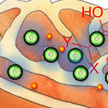 Studies show hat mitochondrial metabolism theoretically is a plausible target for cancer therapy. Mitochondria are the primary controllers of cellular suicide; however, cancer cells trick this normal cellular mechanism and evade this process leading to uncontrolled cellular growth. To trigger the suicide switch back on, new work uses a highly selective nanotechnology-based approach to deliver a widely available small molecule commonly found as a by-product of a water chlorination process.
Studies show hat mitochondrial metabolism theoretically is a plausible target for cancer therapy. Mitochondria are the primary controllers of cellular suicide; however, cancer cells trick this normal cellular mechanism and evade this process leading to uncontrolled cellular growth. To trigger the suicide switch back on, new work uses a highly selective nanotechnology-based approach to deliver a widely available small molecule commonly found as a by-product of a water chlorination process.
Jul 6th, 2016
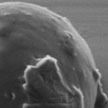 Researchers have demonstrated that the coupling of pristine graphene sheets on practically any polymer surface can be accomplished in mild reaction conditions and in aqueous medium. The method leaves intact the 2D planar structure of graphene preserving its original features. This novel hybrid construct enables in vivo photoacoustic signal enhancement and is a very promising step forward for an implementation of photoacoustic imaging, a powerful preclinical diagnostic tool.
Researchers have demonstrated that the coupling of pristine graphene sheets on practically any polymer surface can be accomplished in mild reaction conditions and in aqueous medium. The method leaves intact the 2D planar structure of graphene preserving its original features. This novel hybrid construct enables in vivo photoacoustic signal enhancement and is a very promising step forward for an implementation of photoacoustic imaging, a powerful preclinical diagnostic tool.
Jun 30th, 2016
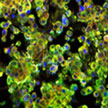 Currently in the clinic and in clinical development, there is heavy emphasis placed on understanding how drugs can be 'complementary'. That is to say, what combination of drugs will be most effective in killing tumor cells and overcome potential resistance mechanisms. In fact, adding synergistic combinations of drugs is reshaping how cancer is treated, even in the context of immunotherapy. A new study provides critical evidence that complementary drugs must be in spatial proximity to truly exert their synergistic potential.
Currently in the clinic and in clinical development, there is heavy emphasis placed on understanding how drugs can be 'complementary'. That is to say, what combination of drugs will be most effective in killing tumor cells and overcome potential resistance mechanisms. In fact, adding synergistic combinations of drugs is reshaping how cancer is treated, even in the context of immunotherapy. A new study provides critical evidence that complementary drugs must be in spatial proximity to truly exert their synergistic potential.
Jun 28th, 2016
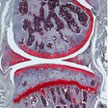 Researchers have shown, using a mouse model of osteoarthritis, that curcumin loaded nanoparticles topically applied to arthritic knees stopped the progression of the disease and eliminated associated pain by locally delivering curcumin to the fat pad associated with the knee cap. The study also demonstrated several osteoarthritis relevant inflammatory pathways were suppressed by curcumin, including those that result in the production of proteins that destroy cartilage.
Researchers have shown, using a mouse model of osteoarthritis, that curcumin loaded nanoparticles topically applied to arthritic knees stopped the progression of the disease and eliminated associated pain by locally delivering curcumin to the fat pad associated with the knee cap. The study also demonstrated several osteoarthritis relevant inflammatory pathways were suppressed by curcumin, including those that result in the production of proteins that destroy cartilage.
Jun 17th, 2016
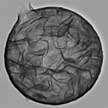 MoS2 nanosheets have shown great prospect as a near-infrared light (NIR) absorbing agent for PTT applications due to their unique photoelectric property, low cost and good biocompatibility. However, the absorbance of nanosheets in the NIR region is not specific and strong, and the photothermal conversion efficiency of MoS2 based materials need to be enhanced. In new work, researchers have proposed a novel MoS2 nanostructure, i.e. layered MoS2 hollow spheres (LMHSs), for improving their near-infrared absorption and photothermal conversion efficiency.
MoS2 nanosheets have shown great prospect as a near-infrared light (NIR) absorbing agent for PTT applications due to their unique photoelectric property, low cost and good biocompatibility. However, the absorbance of nanosheets in the NIR region is not specific and strong, and the photothermal conversion efficiency of MoS2 based materials need to be enhanced. In new work, researchers have proposed a novel MoS2 nanostructure, i.e. layered MoS2 hollow spheres (LMHSs), for improving their near-infrared absorption and photothermal conversion efficiency.
Apr 28th, 2016
 Currently available toxicity screening methods are not fully compatible with nanotoxicity studies. Due to the unique physicochemical characteristics of nanomaterials, conventional cytotoxicity assays have been shown to create complications in nanotoxicity evaluation. In a new study, researchers used surface-enhanced Raman scattering (SERS) to evaluate the cytotoxicity of nanomaterials. They show that SERS can be used as an alternative nanotoxicity evaluation method especially for the nanomaterials that have been shown to create complications in conventional cytotoxicity assays.
Currently available toxicity screening methods are not fully compatible with nanotoxicity studies. Due to the unique physicochemical characteristics of nanomaterials, conventional cytotoxicity assays have been shown to create complications in nanotoxicity evaluation. In a new study, researchers used surface-enhanced Raman scattering (SERS) to evaluate the cytotoxicity of nanomaterials. They show that SERS can be used as an alternative nanotoxicity evaluation method especially for the nanomaterials that have been shown to create complications in conventional cytotoxicity assays.
 Subscribe to our Nanotechnology Spotlight feed
Subscribe to our Nanotechnology Spotlight feed





